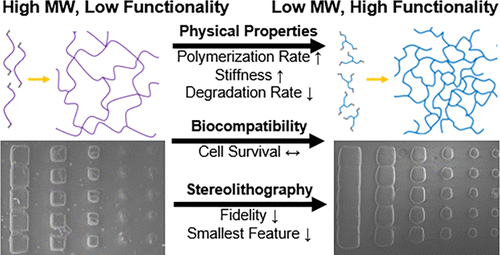当前位置:
X-MOL 学术
›
Biomacromolecules
›
论文详情
Our official English website, www.x-mol.net, welcomes your feedback! (Note: you will need to create a separate account there.)
Effect of Molecular Weight and Functionality on Acrylated Poly(caprolactone) for Stereolithography and Biomedical Applications
Biomacromolecules ( IF 6.2 ) Pub Date : 2018-07-25 00:00:00 , DOI: 10.1021/acs.biomac.8b00784 Brian J. Green 1 , Kristan S. Worthington 2, 3 , Jessica R. Thompson 2, 3 , Spencer J. Bunn 1 , Mary Rethwisch 1 , Emily E. Kaalberg 2 , Chunhua Jiao 2 , Luke A. Wiley 2 , Robert F. Mullins 2 , Edwin M. Stone 2 , Elliott H. Sohn 2 , Budd A. Tucker 2 , C. Allan Guymon 1
Biomacromolecules ( IF 6.2 ) Pub Date : 2018-07-25 00:00:00 , DOI: 10.1021/acs.biomac.8b00784 Brian J. Green 1 , Kristan S. Worthington 2, 3 , Jessica R. Thompson 2, 3 , Spencer J. Bunn 1 , Mary Rethwisch 1 , Emily E. Kaalberg 2 , Chunhua Jiao 2 , Luke A. Wiley 2 , Robert F. Mullins 2 , Edwin M. Stone 2 , Elliott H. Sohn 2 , Budd A. Tucker 2 , C. Allan Guymon 1
Affiliation

|
Degradable polymers are integral components in many biomedical polymer applications. The ability of these materials to decompose in situ has become a critical component for tissue engineering, allowing scaffolds to guide cell and tissue growth while facilitating gradual regeneration of native tissue. The objective of this work is to understand the role of prepolymer molecular weight and functionality of photocurable poly(caprolactone) (PCL) in determining reaction kinetics, mechanical properties, polymer degradation, biocompatibility, and suitability for stereolithography. PCL, a degradable polymer used in a number of biomedical applications, was functionalized with acrylate groups to enable photopolymerization and three-dimensional printing via stereolithography. PCL prepolymers with different molecular weights and functionalities were studied to understand the role of molecular structure in reaction kinetics, mechanical properties, and degradation rates. The mechanical properties of photocured PCL were dependent on cross-link density and directly related to the molecular weight and functionality of the prepolymers. High-molecular weight, low-functionality PCLDA prepolymers exhibited a lower modulus and a higher strain at break, while low-molecular weight, high-functionality PCLTA prepolymers exhibited a lower strain at break and a higher modulus. Additionally, degradation profiles of cross-linked PCL followed a similar trend, with low cross-link density leading to degradation times up to 2.5 times shorter than those of more highly cross-linked polymers. Furthermore, photopolymerized PCL showed biocompatibility both in vitro and in vivo, causing no observed detrimental effects on seeded murine-induced pluripotent stem cells or when implanted into pig retinas. Finally, the ability to create three-dimensional PCL structures is shown by fabrication of simple structures using digital light projection stereolithography. Low-molecular weight, high-functionality PCLTA prepolymers printed objects with feature sizes near the hardware resolution limit of 50 μm. This work lays the foundation for future work in fabricating microscale PCL structures for a wide range of tissue regeneration applications.
中文翻译:

分子量和官能度对丙烯酸酯化聚己内酯在立体光刻和生物医学应用中的影响
可降解聚合物是许多生物医学聚合物应用中不可或缺的组成部分。这些材料原位分解的能力已经成为组织工程学的关键组成部分,它允许支架引导细胞和组织的生长,同时促进天然组织的逐渐再生。这项工作的目的是了解预聚物分子量和光固化性聚己内酯(PCL)的功能在确定反应动力学,机械性能,聚合物降解,生物相容性和立体平版印刷术的适用性方面的作用。PCL是在许多生物医学应用中使用的可降解聚合物,已通过丙烯酸酯基团官能化,从而能够通过立体光刻技术进行光聚合和三维印刷。对具有不同分子量和官能度的PCL预聚物进行了研究,以了解分子结构在反应动力学,机械性能和降解速率中的作用。光固化PCL的机械性能取决于交联密度,并直接与预聚物的分子量和功能性相关。高分子量,低官能度的PCLDA预聚物表现出较低的模量和较高的断裂应变,而低分子量,高官能度的PCLTA预聚物表现出较低的断裂应变和较高的模量。另外,交联的PCL的降解曲线也遵循类似的趋势,低交联密度导致的降解时间比高度交联的聚合物的降解时间短2.5倍。此外,光聚合的PCL均显示出生物相容性 低官能度的PCLDA预聚物表现出较低的模量和较高的断裂应变,而低分子量的高官能度的PCLTA预聚物表现出较低的断裂应变和较高的模量。另外,交联的PCL的降解曲线也遵循类似的趋势,低交联密度导致的降解时间比高度交联的聚合物的降解时间短2.5倍。此外,光聚合的PCL均显示出生物相容性 低官能度的PCLDA预聚物表现出较低的模量和较高的断裂应变,而低分子量的高官能度的PCLTA预聚物表现出较低的断裂应变和较高的模量。另外,交联的PCL的降解曲线也遵循类似的趋势,低交联密度导致的降解时间比高度交联的聚合物的降解时间短2.5倍。此外,光聚合的PCL均显示出生物相容性 比高度交联的聚合物短5倍。此外,光聚合的PCL均显示出生物相容性 比高度交联的聚合物短5倍。此外,光聚合的PCL均显示出生物相容性在体外和体内,未观察到对种子鼠诱导的多能干细胞或植入猪视网膜的有害作用。最后,通过使用数字光投影立体光刻技术制造简单结构,可以显示出创建三维PCL结构的能力。低分子量,高功能性PCLTA预聚合特征尺寸接近硬件分辨率极限50μm的打印对象。这项工作为将来为各种组织再生应用制造微型PCL结构奠定了基础。
更新日期:2018-07-25
中文翻译:

分子量和官能度对丙烯酸酯化聚己内酯在立体光刻和生物医学应用中的影响
可降解聚合物是许多生物医学聚合物应用中不可或缺的组成部分。这些材料原位分解的能力已经成为组织工程学的关键组成部分,它允许支架引导细胞和组织的生长,同时促进天然组织的逐渐再生。这项工作的目的是了解预聚物分子量和光固化性聚己内酯(PCL)的功能在确定反应动力学,机械性能,聚合物降解,生物相容性和立体平版印刷术的适用性方面的作用。PCL是在许多生物医学应用中使用的可降解聚合物,已通过丙烯酸酯基团官能化,从而能够通过立体光刻技术进行光聚合和三维印刷。对具有不同分子量和官能度的PCL预聚物进行了研究,以了解分子结构在反应动力学,机械性能和降解速率中的作用。光固化PCL的机械性能取决于交联密度,并直接与预聚物的分子量和功能性相关。高分子量,低官能度的PCLDA预聚物表现出较低的模量和较高的断裂应变,而低分子量,高官能度的PCLTA预聚物表现出较低的断裂应变和较高的模量。另外,交联的PCL的降解曲线也遵循类似的趋势,低交联密度导致的降解时间比高度交联的聚合物的降解时间短2.5倍。此外,光聚合的PCL均显示出生物相容性 低官能度的PCLDA预聚物表现出较低的模量和较高的断裂应变,而低分子量的高官能度的PCLTA预聚物表现出较低的断裂应变和较高的模量。另外,交联的PCL的降解曲线也遵循类似的趋势,低交联密度导致的降解时间比高度交联的聚合物的降解时间短2.5倍。此外,光聚合的PCL均显示出生物相容性 低官能度的PCLDA预聚物表现出较低的模量和较高的断裂应变,而低分子量的高官能度的PCLTA预聚物表现出较低的断裂应变和较高的模量。另外,交联的PCL的降解曲线也遵循类似的趋势,低交联密度导致的降解时间比高度交联的聚合物的降解时间短2.5倍。此外,光聚合的PCL均显示出生物相容性 比高度交联的聚合物短5倍。此外,光聚合的PCL均显示出生物相容性 比高度交联的聚合物短5倍。此外,光聚合的PCL均显示出生物相容性在体外和体内,未观察到对种子鼠诱导的多能干细胞或植入猪视网膜的有害作用。最后,通过使用数字光投影立体光刻技术制造简单结构,可以显示出创建三维PCL结构的能力。低分子量,高功能性PCLTA预聚合特征尺寸接近硬件分辨率极限50μm的打印对象。这项工作为将来为各种组织再生应用制造微型PCL结构奠定了基础。



























 京公网安备 11010802027423号
京公网安备 11010802027423号